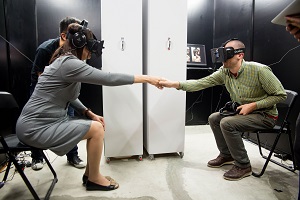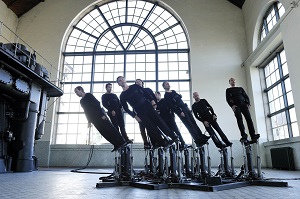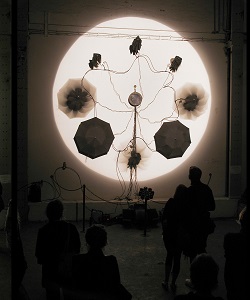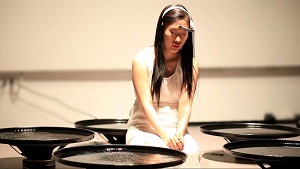Taipei Digital Art Festival features technologically-advanced art forms
By Yali Chen The festival has kicked off at the Nos. 4 and 5 Warehouse in the Songshan Cultural and Creative Park in Taipei and will run through November 23. Now in its ninth year, the event brings together well-known artists from Taiwan and overseas to showcase their artworks. International artists come from Switzerland, the U.K., the U.S., France, and Spain. BeAnotherLab, an interdisciplinary group of students at the University Pompeu Fabra in Barcelona, has developed a virtual reality headset that allows users to try swapping gender. The Machine To Be Another project was initiated by BeAnotherLab as a low-budget experiment that examines how people from different social, theological or cultural backgrounds can experience life from another’s point of view. One of the tests conducted using the technology is called the Gender Swap experiment, which invites users to discover “what would it be like to see through the eyes of the opposite sex?” Users wear a pair of immersive goggles from virtual reality firm Oculus that display a video being transmitted in real time from a camera attached to another headset worn by a performer who can be an actor or anyone interested in describing a particular aspect of their life. The project is inspired by recent findings in neuroscience and virtual reality. The findings on embodiment and empathy examine how the form of the body affects the way people think and act. The designers of BeAnotherLab develop this project with psychologists and neurologists working in fields such as rehabilitation, body perception and conflict resolution. Led by André and Michel Décosterd, Pendulum Choir functions by propping up a chorus of 9 A Capella singers on tilting hydraulic jacks. The choir sways the singing members in unison movements based on the sounds and story they produce as a whole. Ranging from repetitive sounds, abstract noises and lyrically inspired narrative sounds, Pendulum Choir creates a musical performance using the actual bodies of these singers. The group’s latest concept and performance, Pendulum Choir, won the Grand Prize at the 16th Japan Media Arts Festival in 2012 for its creativity. Born in 1970, Peter William Holden grew up in a decaying industrial town in Northern England. His works encompass movement, light and sound with interests around the boundaries between cinematography and sculpture. He also focuses on the transformation of objects, using his knowledge of applied mathematics to create his art installations. Created by the British artist, AutoGene itself is a simple aesthetic looking robot composed of eight modified umbrellas which function as mechanical pixels. The spherically arranged umbrellas expand and contract, along with the accompanying music, creating abstract and ephemeral patterns. These umbrellas are also mounted in a circular pattern and joined via a cocktail of air hoses and electrical cables to a small industrial computer. They follow a pre-programmed sequence which gives the illusion AutoGene can dance to music. This erodes the machines mechanical qualities and transforms the mundane umbrellas into magical animated objects. SoleNoid β is the London-based artist’s another creation. On a circular base, eight black and white tap-shoes perform a rhythmic dance in SoleNoid β. Activated by a member of the public pressing a button on a control panel that has sixteen different switches, robots in SoleNoid β are tap dancing, autonomous and controlled. The robots are programmed to produce the perfect tap dance moves, so viewers can enjoy the tap dance sounds and pleasure easily. Lisa Park is a multidisciplinary artist from South Korea who is currently based in New York City. Exploring questions of vulnerability, self-control and liberation, Park created her work, called Euonia, which is Greek for “beautiful thought.” The EEG headset Park used to record her brain activity is called MindWave and is created by California-based neurology experts NeuroSky. It is traditionally used to measure brainwave signals in students to monitor their attention levels during math, memory, and pattern recognition tests. The EEG headset can measure Park’s eye movements, along with the alpha, beta, delta, gamma, and theta waves of her brain. The data is collected in real-time and sent via Bluetooth to a computer where the software programs Processing, Max/MSP, and Ableton Live to translate it into sounds. Each of the different sounds was assigned to one of five speakers placed beneath trays of water. Each of the speakers was assigned a different emotion, including anger, hate, desire, sadness and happiness. This meant Park and her audience could see exactly which speaker was playing the sound based on the jumping water droplets. The goal of Park’s work is to use technology to engage and evoke human emotions rather than alienation and create art that empowers the public through awareness of them. Apart from international digital artworks, the AnimA 2014 is also certainly not to be missed! This year’s animation festival includes a total of 72 animated films shown in the 2013 Brussels Animation Film Festival, the 2013 SIGGRAPH ASIA Computer Animation Festival, the 2014 Annecy International Animation Film Festival, and the 2014 Ottawa International Animation Festival. The event allows Taiwan’s audience to experience the energy of creativity and the state-of-the-art animations around the world. French artist taking part in the Artists-in-Residence Taipei, Félix Lachaize created his Digital Wheelbarrow Project. Lachaize roamed through the city of Taipei to collect a wide variety of objects in his wheelbarrow. In his project, the wheelbarrow is equipped with various instruments and tools, such as digital recording devices (camera and microphone), information systems (a global positioning system and word processing software), and practical tools (vices and feather duster). The tools extract the most interesting parts and highlight their qualities. All the objects are put back where they were found. Thanks to the recording devices, Lachaize could create digital files and documents to show objects, actions and settings. At last, he classified and stored these gigabytes with information about the localization and his feelings about the place. Taiwanese artist Wang Lien-cheng’s works involve the use of interactive devices with sound performances. In Parallel Cities, with a high-speed direct-current motor, Wang shapes laser beams into a light tube to imply that the space is full of pipes and cables. He also uses semi-reflecting mirrors to simulate the flood of pipes and cables in a city. These pipes and cables are visible but untouchable. In other words, this work deals with the direct relationship among the pipes, cables and city residents. “Taipei Digital Art Festival 2014: Ecosystem”
STAFF WRITER The 2014 Taipei Digital Art Festival, titled Ecosystem, features a wide variety of exhibitions, animated film screenings, performances, and forums that cast a spotlight on the technologically-advanced art forms.
The 2014 Taipei Digital Art Festival, titled Ecosystem, features a wide variety of exhibitions, animated film screenings, performances, and forums that cast a spotlight on the technologically-advanced art forms. Pendulum Choir is one of the latest projects of Swiss art group Cod.Act, an original work for a choir of 9 male singers and 18 hydraulic jacks. Cod.Act’s ideas often come from observations of acoustical, physical, mechanical, and chemical phenomena.
Pendulum Choir is one of the latest projects of Swiss art group Cod.Act, an original work for a choir of 9 male singers and 18 hydraulic jacks. Cod.Act’s ideas often come from observations of acoustical, physical, mechanical, and chemical phenomena. Wearing a futuristic headset embedded with electroencephalography (EEG) sensors, the artist monitors her own brain activity during meditation and transposes this energy onto dishes of water to reveal zen-like vibrations.
Wearing a futuristic headset embedded with electroencephalography (EEG) sensors, the artist monitors her own brain activity during meditation and transposes this energy onto dishes of water to reveal zen-like vibrations. In Taipei, the French artist plans to give a performance looking like a kind of software program that classifies data. His tap-shoes will rummage through documents, doing away with some, while playing with others.
In Taipei, the French artist plans to give a performance looking like a kind of software program that classifies data. His tap-shoes will rummage through documents, doing away with some, while playing with others.
Telephone: 02-7736-0708
Address: Nos. 4 and 5 Warehouse in the Songshan Cultural and Creative Park, Taipei City
Hours: 10:00am – 6:00pm Sundays to Mondays, 10:00am – 8:00pm Fridays and Saturdays

![Taiwan.gov.tw [ open a new window]](/images/egov.png)
